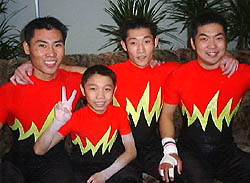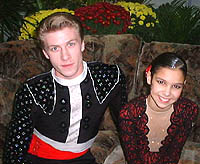| . |
Not
all the same players will be present in Riesa; a new generation of
gymnasts will take their first steps in the international arena.
Luck might change camps!
A
new competition format will be used at the Riesa World Championships.
A lighter, more modern and more spectacular program has been
adopted by the FIG, so that this discipline can gain rating points and
appeal to an increasing number of television viewers and spectators.
|
The
Disciplines are
In
Men’s Duos, the Chinese champions of Akita will be
in the
running. Li Renjie and his partner Song Min are ready
to defend their title;
“buddies”, be warned!
Same
scenario for the Women’s Duos, but this time,
the “women to beat”
are Russians and their names are
Yulia Lopatkina and Anna Mokkhova. |

Title holder Wroclaw
2000: Chinese Men's Group
|
|
| |

Russian Mixed Pair:
Jakowlew/Lymares
|
  From
the Mixed Doubles emanates a strong whiff of conspiracy!
From
the Mixed Doubles emanates a strong whiff of conspiracy!
The
Akita winners will not be there, but Russia has enlisted a new
pair for Riesa, to defend the title.
On the other hand, the American, British, and Chinese competitors,
respectively ranked 2nd, 3rd and 4th
are the same players as in 2001.
All of them will likely try not to suffer the same losses
as in Akita!
|
For
the Women’s Groups, only the Byelorussia gymnasts came close
to the Akita prefecture. The USA, Great Britain, and China will introduce
new trios. A new hierarchy will be established in Riesa 2002.
COMPETITION
I (Qualification):
These competitions must be entered by all pairs or groups
aiming to qualify for Competitions II (Finals). All pairs and groups
perform 3 exercises, 1 Balance, 1 Tempo and 1 Combined.
The starting order of the Balance and Tempo Exercises will be determined
by two different draws. The starting order of the third exercise to be
performed, will be in reverse rank order after completion of the first two
exercises.
The
8 highest scoring pairs and groups in each category, after the 3 exercises
in Competition I, proceed to Competition II (Final). When there are less
than 12 participants in a category, only 6 will proceed to the Final. Not
more than one pair or group per federation in each category is allowed to
proceed to this Final.
The
results from Competition I also count for the team ranking as set out in
Reg. 3.4.3
Competition
II (Finals)
This
competition determines the World Champions per category.
The
starting order will be determined by draw, with those placed 5-8 first and
those placed 1-4 after.
In
case of 6 participants in the finals, those placed 5 and 6 will perform
first and second with the position determined by draw; those placed 1 to 4
will perform after with the order determined by draw.
- The
competition starts from a mark of zero.
- The
pairs/groups with the highest points in each category are declared World
Champions in their particular categories.
COMPETITION
III (TEAM RANKING)
The
team classification is established on the basis of the 4 best overall
placings of team members over the 3 exercises performed in Competition I,
by 2 different pairs, and 2 different groups, out of the 5 categories.
The 4 best
placings are converted into points as follows :
e.g.
If 16 countries are entered in a World Championships, the first place gets
16 points, the second place 15, the third place 14 etc.
All
categories get a uniform conversion regardless of the number of
competitors in the event.
The
team with the highest number of points is declared Team World Champion.
Each member of the team is awarded a medal.
Finally,
the encounter between the Men’s Groups promises to be exciting. Russia
will present a new group. China
is lining up the same elements. Portugal replaced Mateus with Joao Godinho.
Ranked 4th last year in Akita, Great Britain has faith in its
own group. Here again, the
“old” teams may unite against the newcomers.
But Russia is a large country and has resources and a lot of
talents. The surprise may
well come from a Russian victory! (information by F.I.G.)
 
 Preview in German / Vorschau in deutsch
Preview in German / Vorschau in deutsch
  RESULTS
RESULTS |
  Remembering
/ Rückblende:
Remembering
/ Rückblende: |
|